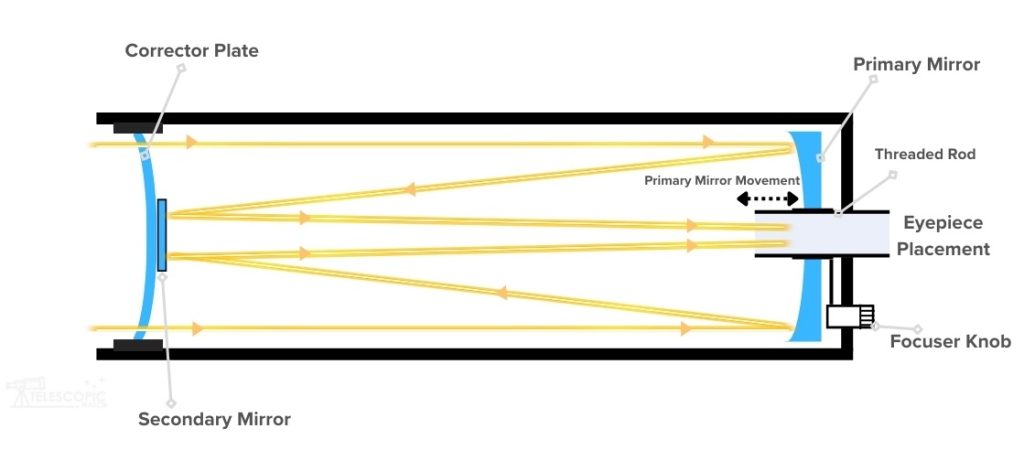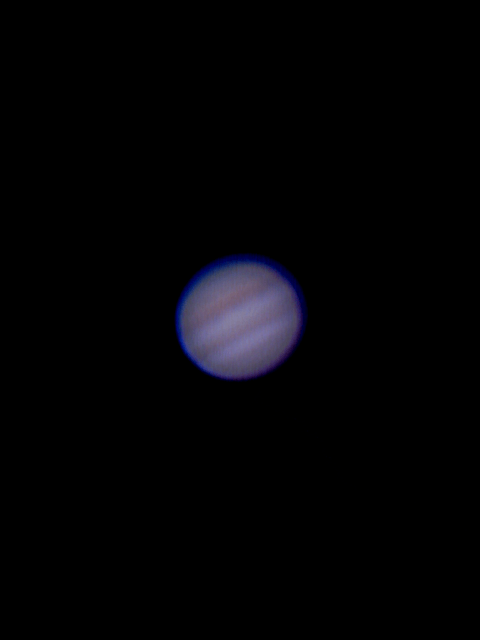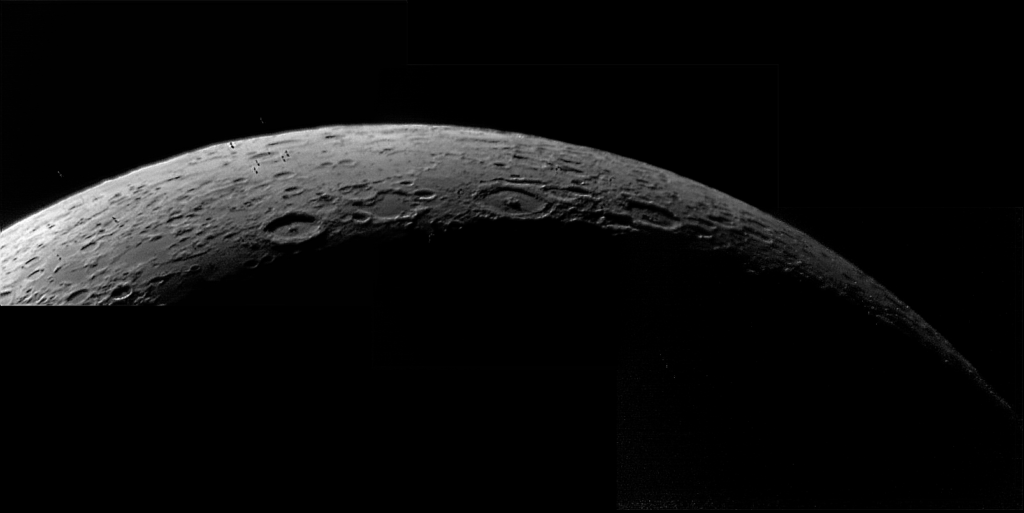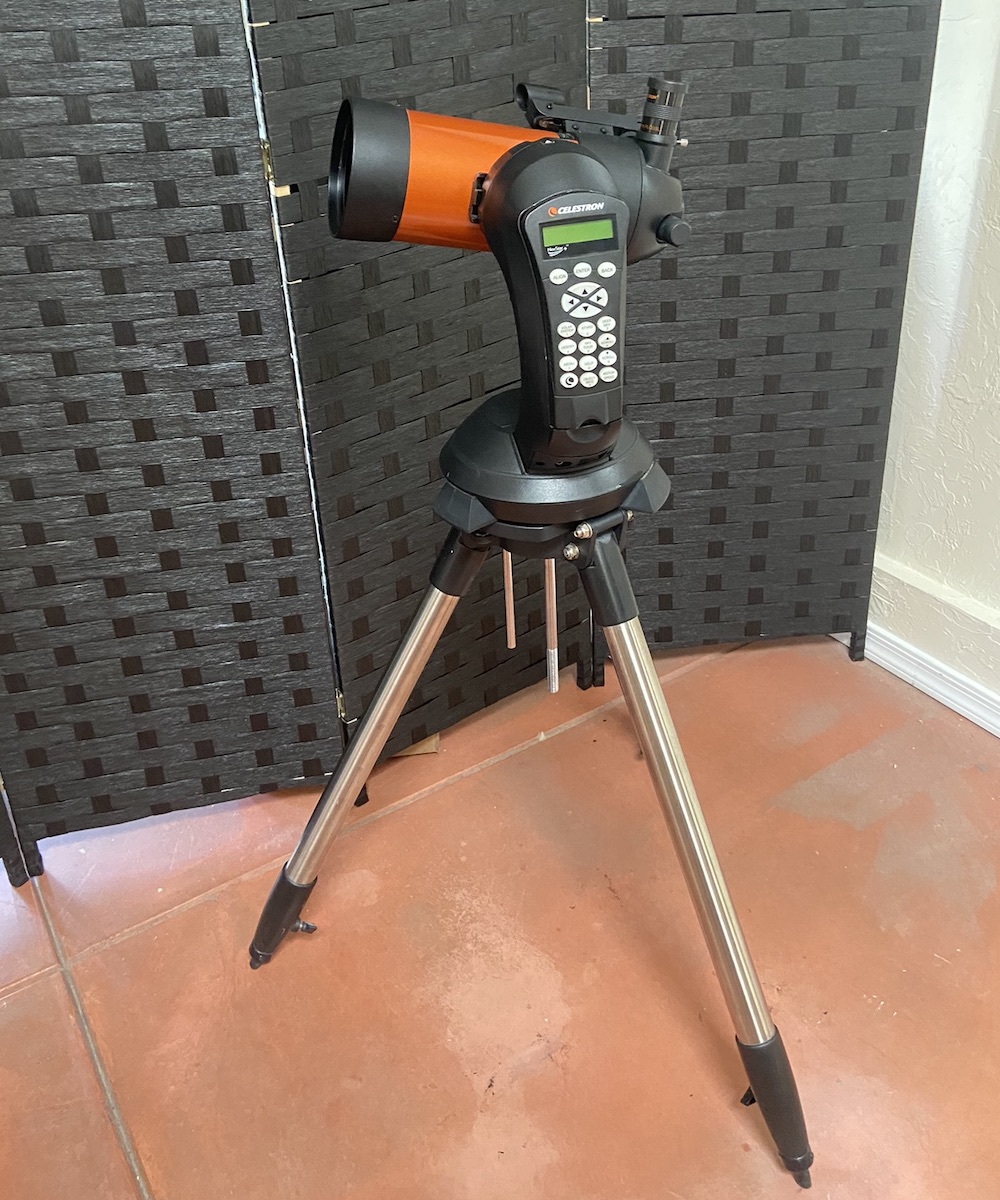The Celestron 4SE Optical Tube
The Celestron NexStar 4SE computeriSed telescope is a Maksutov-Cassegrain telescope with an aperture of 4” (102mm) and a focal length of 1325mm, giving it a focal ratio of f/13.
The Maksutov-Cassegrain design uses a very fast spherical primary mirror with a meniscus corrector lens and an aluminised “spot” on the corrector serving as the secondary mirror. The Celestron NexStar 4SE, like most mass-manufactured Maksutovs today, is a variant called the Gregory-Maksutov, where the secondary is nothing more than an aluminised spot on the back of the corrector lens.

The Benefits of 4SE’s Maksutov Design
Maksutov-Cassegrains, also referred to simply as Maks or Maksutovs, have small secondary mirrors and long focal ratios (typically f/12 to f/15), and the corrector lens and mirrors are very easy to make to high tolerances, making them provide stunning, sharp lunar and planetary views.
Since the secondary mirror in a Gregory-Mak is simply an aluminised portion of the corrector plate, commercial Maksutovs almost never need collimation. Some don’t have any provisions for doing it at all, but the NexStar 4SE has a few small collimation screws in the back that an experienced user could adjust for collimation.
The Pointless Flip Mirror
The 4SE has an integrated “flip mirror” at the back, which means that there is a built-in star diagonal that can be retracted to allow light directly out of the back of the telescope and into a camera adaptor, usually for a DSLR or mirrorless camera. But this isn’t really necessary.
This flip mirror simply adds some additional bulk and complexity to the telescope and requires an unusual threaded adaptor to be utilised. A normal Maksutov gets by with the user just detaching the star diagonal. The 4SE isn’t really intended for astrophotography anyway, especially not with a DSLR or mirrorless camera, which are primarily meant for long exposures.
NexStar 4SE’s Small Field Of View and It’s Effects
The Celestron NexStar 4SE, with its long focal length of 1325mm and use of 1.25” eyepieces, is limited to a maximum field of view of around just 1.2 degrees—or about 2.5 times the diameter of the full Moon. That’s a rather small figure for a 4” telescope.
An even larger aperture (130mm) but cheaper instrument, such as the Sky-Watcher Virtuoso GTi 130P, can get 2.5 degrees of field of view—more than double that of the Celestron NexStar 4SE (and they cost a fraction as much, to boot).
Of course, I realise that most of the advantages of that extra field of view are simply in finding objects manually, which the Nexstar 4SE does not need to worry about due to its fully computerised mount. However, a wide field of view is still desirable for many of the large star clusters, asterisms, and nebulae that a small telescope excels at.
Make no mistake: the Celestron NexStar 4SE is really a planetary telescope. Most deep-sky objects either don’t fit in 4SE’s field of view or don’t look particularly impressive.
If all you’re looking at is the planets, the Moon, and perhaps a few double stars, how much do you really need GoTo anyway?
Offering Just a Single Eyepiece & a Red Dot Finder
The Celestron NexStar 4SE computerised telescope comes with a single 25mm Plossl eyepiece, yielding 55x. This is good as a low-power or “finder” eyepiece for viewing deep-sky objects and initially aligning the telescope. But if you still want the best, for the widest possible field of view and lowest magnification with the 4SE, a 32mm Plossl is my favourite choice.
For optimal usage of the telescope, you’ll want something for higher magnifications. Specifically, a good high-magnification eyepiece in the 6mm to 9mm range, such as “goldlines”, the Meade 8.8mm UWA, or another eyepiece such as a Baader Hyperion or Explore Scientific 82-degree.
The only other accessory included with the 4SE is its StarPointer red-dot finder, which is used for aligning the telescope’s GoTo system.
The NexStar 4SE Mount
The NexStar SE mount is similar in all versions, but the 4SE and 5SE have a shorter fork arm on the mount and a base with 3 foot-like bits sticking out. It’s a holdover from the days of the NexStar 4GT, the 4SE’s predecessor, which was sold as a tabletop telescope.
The mount is well-made.
The gears in it are a bit better than the cheaper NexStar SLT scopes. But they still give me a lot of backlash, which is somewhat problematic when I’m moving the telescope at high powers or attempting to shoot planetary images.
The tripod legs are, however, solid steel. The whole assembly is actually somewhat overkill for the Celestron NexStar 4SE’s tiny optical tube.
One thing I’d like you to keep in mind with the SE mount is that the power jack can lose connection, which will shut down the mount. The mount then requires re-booting and re-aligning. I solved this issue by installing AA batteries in the scope as a backup.
The 4SE’s tripod has an “equatorial wedge,” which theoretically allows the scope to be converted to an equatorial configuration. However, without accurate altitude adjustments or any azimuth adjustment to speak of, short of picking up or kicking the entire scope/mount/tripod combination, an equatorial mount is only needed for deep-sky astrophotography. Deep-sky astrophotography is something that the 4SE, with a focal ratio of f/13, is simply not capable of (the mount’s mediocre gearing quality doesn’t help, either).
Why The Mount Doesn’t Make Much Sense To Me
The biggest issue I have with the 4SE’s mount is that it doesn’t make much sense.
The mount weighs 17 pounds, much more than it needs to weigh. It must be perfectly levelled during setup, especially if you want the SkyAlign easy-align feature to work. It either burns through lots of AA batteries frequently or needs a good, steady source of DC or AC power. And, of course, it has to actually be aligned.
All this is done in order to use a scope that, in all likelihood, can rarely be pointed at objects that can’t be found with the naked eye, a simple star chart, or even a phone app like SkySafari. Also, all of this is at the price of an 8” Dobsonian, which has four times the light-gathering ability, double the resolution, and a similar setup time at worst.
What can you see with the Celestron NexStar 4SE?
The Celestron NexStar 4SE shines primarily on the moon and planets.
- We can easily see lunar details just a few miles across, as well as the phases of Venus and Mercury.
- Mars will show its ice cap and some dark markings when it is close to Earth.
- Jupiter’s cloud belts, polar and equatorial zones, and Great Red Spot are visible, and its four largest moons, the Galilean Moons Io, Europa, Ganymede, and Callisto, appear as tiny, not-quite-stellar dots. With good atmospheric seeing, we can just see their shadows as they transit across the planet.
- Saturn’s rings, the Cassini division within them, and some faint, low-contrast cloud bands on the planet itself are no problem, and we are easily able to catch its largest moon, Titan, along with smaller moons such as Enceladus, Hea, Tethys, Dione, and Iapetus.
- Uranus and Neptune are nothing more than turquoise and deep blue dots; we would struggle to resolve the latter as more than a star at all.
Outside the solar system, the 4SE is relatively limited.
- Most galaxies, such as Andromeda, M81, and M51, appear as vague smudges of varying sizes under all but the best conditions (Andromeda and M33 will also be unable to fit into a single field of view with the 4SE). M82 is the only one that might show any detail, especially under light-polluted skies, in the form of a cigar shape and dark streaks perpendicular to it.
- Globular clusters are merely brightish fuzzy balls with maybe the slightest hint of resolution.
- A fair amount of open clusters are visible with the 4SE, but many are visually unappealing to beginners or don’t fit in the field of view.
- There are also a couple dozen nebulae visible with the scope, but overall, if you’re looking for mind-blowing views of deep-sky objects, you should probably look elsewhere. Visible does not mean spectacular.
Astrophotography with the NexStar 4SE
The Celestron NexStar 4SE GoTo telescope does well at lunar and planetary astrophotography.

I’ve attached a few images that I took with my NexStar 4SE and a cheap 640×480 webcam that I found at a flea market and attached a 1.25” nosepiece and 2x Barlow lens to.

Forget deep-sky astrophotography, however. The 4SE’s f/13 focal ratio, mediocre tracking capabilities, and the alt-az nature of the mount do not allow for good long exposure photos.
Aftermarket Accessory Recommendations
The NexStar 4SE package includes very few accessories besides its diagonal and single 25mm Plossl eyepiece, making it crucial to acquire several key upgrades and additional eyepieces to fully utilise this telescope. For starters, I would certainly recommend a dew shield for the 4SE, as with any catadioptric telescope, to reduce glare from nearby light sources entering the telescope, as well as to delay frost or dew formation on the 4SE’s front corrector plate, and to protect it from pollen, dirt, and dust.
A medium-power eyepiece for the NexStar 4SE such as the 15mm redline or goldline (88x), along with a 9mm redline/goldline for high magnification (147x) are likely to be all you need to complement the 4SE’s stock 25mm Plossl. However, a 32mm Plossl eyepiece for 41x magnification with the NexStar 4SE offers a marginally wider field of view and reduced magnification compared to the supplied 25mm Plossl, making it a little more suitable for observing deep-sky objects, though the 4SE nonetheless remains a mostly planetary-optimised instrument.
Finally, unless you want to go through a lot of disposable batteries, a rechargeable power supply is a must-have for a computerised telescope like the NexStar 4SE. I recommend the Celestron PowerTank Lithium or a more affordable TalentCell power pack for consistent 12v power over multiple observing sessions for the 4SE.
Alternative Recommendations
The Celestron NexStar 4SE is a decent enough telescope, but given its lack of performance or anything resembling good value for the money we have quite a few alternative recommendations, regardless of whether you want a smaller and portable computerised instrument or a larger but more capable Dobsonian telescope.
Under £550
- The StellaLyra 8”/Zhumell Z8/Orion SkyLine 8 offers double the resolving power, quadruple the light gathering area, and a significantly easier to use and more stable mount than that of the NexStar 4SE. You also get a pile of decent accessories included and features like a built-in cooling fan and 2” dual-speed Crayford focuser.
- The Ursa Major 8 once again offers double the resolving power and 4x the light collecting ability of the NexStar 4SE thanks to its big primary mirror, though it’s a little less well-equipped and also a little less expensive than the StellaLyra 8”/Z8 package. The Ursa Major 8 still features the performance of any good 8” Dobsonian and is easy to upgrade with additional parts and accessories at your convenience later.
- The Sky-Watcher Virtuoso GTi 150P features GoTo just like the NexStar 4SE, but its 6” of aperture provides 50% more resolving power and about double the image brightness of the 4SE. As with the 4SE, you get a very compact instrument with GoTo, but with more performance and a lower price tag, controlled via your smartphone or tablet instead of a keypad. The 150P’s f/5 focal ratio and mere 750mm focal length produce a much wider field of view, too, and the telescope can be aimed manually with or without being powered on. The Heritage 150P also offered by Sky-Watcher is essentially identical to the Virtuoso GTi 150P apart from its lack of electronics, making it a purely manual scope (but a great budget pick).
- The Sky-Watcher Virtuoso GTi 130P is similar to the GTi 150P but with less aperture. You get the same performance boost over the 4SE, a much wider field of view, and a GoTo telescope that can also be used manually, all in a super-compact form factor and at a very low price. As with the Virtuoso GTi 150P, Sky-Watcher offers a manual version of the 130P – the beloved Heritage 130P – at an even lower price which is identical apart from the lack of electronics.
- The Celestron Astro-Fi 130 boasts the same 130mm f/5 optics as the GTi 130P and is similarly operated with a smartphone, but is mounted atop a full-sized tripod, lacks a collapsable tube, and cannot be aimed manually. However, if you want a fairly compact and wide-field instrument that’s mounted atop a tripod, few better options exist in this price bracket than the Astro-Fi 130.
- The Celestron Astro-Fi 102 has the same optics as the NexStar 4SE, but without the latter’s goofy flip mirror and with a lighter and more advanced mount which can be controlled by your smartphone. A 10mm Kellner eyepiece is included along the stock 25mm, unlike the 4SE. If you like the NexStar 4SE, the Astro-Fi 102 has all the same positives but with a load of improvements.
£550-£1000
- The StellaLyra 10”/Zhumell Z10/Orion SkyLine 10 has 2.5x the resolution of the NexStar 4SE and more than 6.5x the light gathering area thanks to its humongous 10” primary mirror. The included accessories and features, as with the StellaLyra 10”/Z10, are simply excellent, the simple Dobsonian mount is a joy to use, and you get a ton of performance for the price.
- The Celestron StarSense Explorer 8” Dobsonian is similarly poorly accessorised to the NexStar 4SE – just one 25mm Plossl eyepiece and a red dot finder are included – but this scope offers some computerised capability in the form of the StarSense Explorer technology, which turns your phone into a precision pointing device allowing you to find thousands of faint fuzzy deep-sky objects in seconds by pushing the scope around the sky. The Dobsonian base is also lightweight and the tube features carry handles to increase portability, too.
- The Sky-Watcher 8” FlexTube Dobsonian is a little more compact and thus easier to store and transport than a standard commercial 8” f/6 Dobsonian telescope thanks to its collapsable strut tube, and includes an ample accessory kit (two 1.25” eyepieces and a straight-through 9×50 finder scope). However, the collapsable tube requires more assembly time and often more frequent collimation in the field, and isn’t significantly lighter than a solid-tubed instrument.


